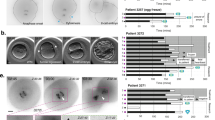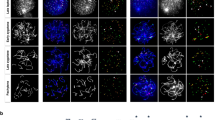Abstract
ALTHOUGH many unfertilised mouse oocytes have been variously stimulated to develop into embryos—parthenogenones—all have died soon after implantation1. The suggested causes of this failure include homozygosity of recessive lethals and an incomplete cortical reaction1. It is not known whether the lack of the paternally-derived genome inhibits their proper development. Using selective silver staining2,3 we have examined the activity of the genes for 18S and 28S ribosomal RNA during preimplantation development of parthenogenones. From studies of the activity of nucleolus organisers on the chromosomes of human–mouse cell hybrids, it has been assumed that silver precipitation was a consequence of gene activity for 18S and 28S rRNA (refs 4–6). Our results indicate that these genes are activated during early embryogenesis and without the need for paternally-derived factors.
This is a preview of subscription content, access via your institution
Access options
Subscribe to this journal
Receive 51 print issues and online access
$199.00 per year
only $3.90 per issue
Buy this article
- Purchase on Springer Link
- Instant access to full article PDF
Prices may be subject to local taxes which are calculated during checkout
Similar content being viewed by others
References
Tarkowski, A. K. J. Reprod. Fert. Suppl. 14, 31–39 (1971).
Denton, T. E., Howell, W. M. & Barrett, J. V. Chromosoma (Berl.) 55, 81–84 (1976).
Bloom, S. E. & Goodpasture, C. Hum. Genet. 34, 199–206 (1976).
Miller, D. A., Dev, V. G., Tantravahi, R. & Miller, O. J. Expl Cell Res. 101, 235–243 (1976).
Miller, O. J., Miller, D. A., Dev, V. G., Tantravahi, R. & Croce, C. M. Proc. natn. Acad. Sci. U.S.A. 73, 4531–4535 (1976).
Croce, C. M., Talavera, A., Basilico, C. & Miller, O. J. Proc. natn. Acad. Sci. U.S.A. 74, 694–697 (1977).
Tarkowski, A. K., Witkowska, A. & Nowicka, J. Nature 226, 162–165 (1970).
Hansmann, I., Gebauer, J., Bihl, L. & Grimm, T. Expl Cell Res. (in the press).
Manes, C. The developmental biology of reproduction (eds C. L. Markert & J. Papaconstantinou) 133 (Academic, New York, 1975).
Graham, C. F. & Deussen, Z. A. J. Embryol. exp. Morph. 31, 497–512 (1974).
Author information
Authors and Affiliations
Rights and permissions
About this article
Cite this article
HANSMANN, I., GEBAUER, J. & GRIMM, T. Impaired gene activity for 18S and 28S rRNA in early embryonic development of mouse parthenogenones. Nature 272, 377–378 (1978). https://doi.org/10.1038/272377a0
Received:
Accepted:
Published:
Issue Date:
DOI: https://doi.org/10.1038/272377a0
This article is cited by
-
In vitro development of spontaneously activated bovine oocytes
Journal of Assisted Reproduction and Genetics (1996)
Comments
By submitting a comment you agree to abide by our Terms and Community Guidelines. If you find something abusive or that does not comply with our terms or guidelines please flag it as inappropriate.



